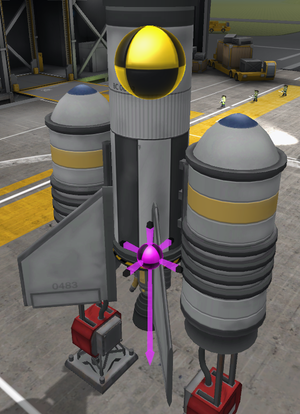Difference between revisions of "Center of mass"
(Clarified and corrected grammar.) |
(General rewrite) |
||
| Line 1: | Line 1: | ||
[[File:com icon.png|framed|left|Icon]] | [[File:com icon.png|framed|left|Icon]] | ||
[[File:Com and cot.png|thumb|The thrust points away from the CoM]] | [[File:Com and cot.png|thumb|The thrust points away from the CoM]] | ||
| − | The ''' | + | The '''Center of Mass''' (abbreviated '''COM''' or '''CoM''') is the point within an object where all mass is equally distributed around it. This is sometimes wrongly called its ''center of gravity'' (see below). |
| − | + | Along with the [[center of thrust]] (COT), and the [[center of lift]] (COL) while within an [[atmosphere]], it is one of the key physics properties determining a [[craft]]'s behavior while in motion, and thus deserves careful attention. Display of these centers can be toggled in the [[Editor]]. | |
| − | + | == Usage == | |
| + | The Center of Mass is distinct in being a point without a vector, and more so for acting as the fulcrum for the forces of [[w:Thrust|thrust]] and [[w:Lift (force)|lift]]. In short, the position of a craft's Center of Thrust and the thrust vector should be in an axial alignment with the COM; otherwise it will cause the craft to turn off course. The Center of Lift is more complex, but in most cases it should be near the COM but on the tailward side and centered side-to-side, and possibly top-to-bottom, while in flight; otherwise the craft may pitch or yaw more uncontrollably the faster it goes. For more detail, see their respective articles. | ||
| + | |||
| + | The Center of Mass will shift as fuel is consumed or stages detached. It is not possible to see the COM, or the other centers, outside the Editor. However, temporarily taking stages off or using [[tweakable]]s to alter the fuel level, or both, will alter the position of the COM and other centers. This can reveal issues that could result in nonstandard flight profiles before actually launching. | ||
== Center of gravity == | == Center of gravity == | ||
| Line 11: | Line 14: | ||
In Kerbal Space Program, this difference of gravity is ignored, so the gravity is always the same on all parts of a craft, and thus both centers are in the same place. | In Kerbal Space Program, this difference of gravity is ignored, so the gravity is always the same on all parts of a craft, and thus both centers are in the same place. | ||
| + | |||
| + | Unlike in real life, the center of mass of two celestial bodies, called the barycenter, e.g. [[Kerbin]] and [[Mun]], is always in the center of the orbited body, which is in the example Kerbin. | ||
== See also == | == See also == | ||
Revision as of 05:25, 3 March 2015
The Center of Mass (abbreviated COM or CoM) is the point within an object where all mass is equally distributed around it. This is sometimes wrongly called its center of gravity (see below).
Along with the center of thrust (COT), and the center of lift (COL) while within an atmosphere, it is one of the key physics properties determining a craft's behavior while in motion, and thus deserves careful attention. Display of these centers can be toggled in the Editor.
Usage
The Center of Mass is distinct in being a point without a vector, and more so for acting as the fulcrum for the forces of thrust and lift. In short, the position of a craft's Center of Thrust and the thrust vector should be in an axial alignment with the COM; otherwise it will cause the craft to turn off course. The Center of Lift is more complex, but in most cases it should be near the COM but on the tailward side and centered side-to-side, and possibly top-to-bottom, while in flight; otherwise the craft may pitch or yaw more uncontrollably the faster it goes. For more detail, see their respective articles.
The Center of Mass will shift as fuel is consumed or stages detached. It is not possible to see the COM, or the other centers, outside the Editor. However, temporarily taking stages off or using tweakables to alter the fuel level, or both, will alter the position of the COM and other centers. This can reveal issues that could result in nonstandard flight profiles before actually launching.
Center of gravity
Sometimes, instead of center of mass, the term center of gravity is used, which describes a similar but distinct concept. Because gravity weakens with the distance to the gravity source, a long rod pointing away from the source would experience different gravitational pull at different points along its length. The "lower" end is being pulled harder than the "high" end; therefore, its center of gravity would be nearer to the gravity source than its center of mass.
In Kerbal Space Program, this difference of gravity is ignored, so the gravity is always the same on all parts of a craft, and thus both centers are in the same place.
Unlike in real life, the center of mass of two celestial bodies, called the barycenter, e.g. Kerbin and Mun, is always in the center of the orbited body, which is in the example Kerbin.
See also
- Center of lift
- Center of thrust
- Center of mass on Wikipedia
